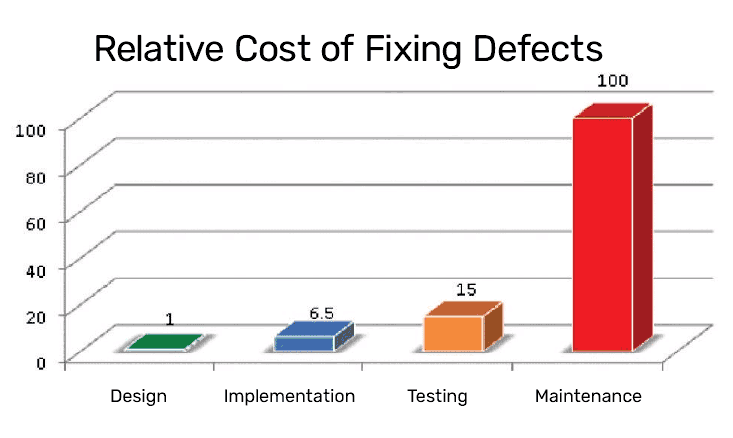The software testing world has undergone a massive evolution to keep up with the growing demand for high-quality software delivered in a shorter timeframe. Traditionally, developers have followed the Software Development Lifecycle (SDLC), a systematic process used to design, develop, and test high-quality software. However, with the shift in demand, companies have had to look for alternative solutions to produce high-quality products. Shift left testing is one such solution to this growing demand.
About Shift Left Testing
With the traditional SDLC approach, software testing is done towards the end of the development cycle. During the testing phase, companies are inevitably faced with a cost associated with identifying and categorizing issues and implementing changes to the development process. The larger the issue found, the more expensive it can be, and may even result in delayed releases.
According to the IBM System Science Institute, fixing an error found during the testing phase is 15 times more expensive than fixing an error found during the design phase, and up to 100 times more expensive during the maintenance phase.

Enter shift-left testing, a practice in software development where testing is performed earlier in the SDLC. Instead of testing towards the end of the development lifecycle, testing is “shifted left” towards the design and implementation phases. This approach emphasizes early and frequent testing throughout the development process, aiming to identify and address issues as soon as they arise rather than at the end of the development cycle.
Shift Left Testing Types
The following tests can be shifted left and performed early in the development lifecycle:
- Static Testing: Involves reviewing the code, documentation, and design documents without actually executing the code. It can include manual reviews, static analysis tools to detect potential issues, and automated checks for coding standards.
- Unit Testing: Focuses on testing individual components or units of the software to ensure they work correctly in isolation. Developers typically conduct these tests as they write the code.
- Integration Testing: Involves testing the interactions between different units or components of the application. Implementing this test early can identify interface defects and issues that arise before the system becomes too complex.
- Security Testing: Involves using automated tools to perform static and dynamic analysis of the code for security vulnerabilities and incorporating security best practices into the development process from the start.
- Performance Testing: Involves evaluating the application’s performance, including its responsiveness and scalability, under various conditions. Implementing this test early can identify and address potential bottlenecks and performance issues before they become ingrained in the software architecture.
The Benefits of Shift Left Testing
Early Bug Detection
By integrating testing early in the SDLC, shift left testing allows for the detection of bugs and issues at the initial stages of development. This early detection is particularly beneficial in mobile app development, where fixing bugs in later stages can be more complex and costly due to the diverse range of devices and operating systems.
Enhanced Quality
Shift-left testing promotes a quality-first mindset among development teams. By incorporating testing from the start, it ensures that quality is a primary consideration throughout the development process, leading to higher quality mobile apps with fewer defects at launch.
Reduced Development Costs and Time
Identifying and addressing defects early in the development process significantly reduces the time and resources required for rework. This efficiency is crucial in maintaining a competitive edge and promptly meeting market demands.
Improved Collaboration and Communication
Shift-left testing encourages closer collaboration between developers, testers, and other stakeholders. This collaborative approach ensures that everyone clearly understands the app’s requirements and objectives, leading to more effective and efficient development and testing processes.
Better Risk Management
By identifying potential issues and risks early, shift left testing allows development teams to make informed decisions and adjustments before investing significant resources.
Automation and Continuous Integration
Shift left testing often involves the use of automated testing tools and continuous integration (CI) practices, which are well-suited to the dynamic nature of mobile app development. Automation and CI enable frequent and consistent testing, ensuring that each change is validated, thereby maintaining the app’s stability and quality throughout the development process.
Enhanced User Satisfaction
Ultimately, shift left testing aims to produce a high-quality product that meets or exceeds user expectations. For mobile apps, where user experience is paramount, early and continuous testing ensures that the app is reliable and user-friendly, leading to greater user satisfaction and loyalty.
Challenges with Shift Left Testing
While shift-left testing offers numerous benefits, it also comes with several challenges that organizations need to consider:
- Learning Curve: Teams not accustomed to integrating testing early in the development cycle face a learning curve.
- Potential Overhead: For smaller projects or teams, the overhead of setting up and maintaining a comprehensive shift-left strategy may not always be justified by the benefits, especially if the project is not complex enough to warrant such an approach.
- Collaboration Hurdles: Shift-left testing requires close collaboration between developers, testers, and other stakeholders. Establishing this collaborative environment can be difficult in organizations with rigid departmental silos.
- Risk of Test Redundancy: There’s a risk of creating redundant tests if the shift-left strategy isn’t properly managed, leading to wasted efforts and resources.
- Potential Neglect of Later Stage Testing: There’s a risk that focusing too much on early-stage testing could lead to a neglect of thorough testing in later stages, such as system, acceptance, or user experience testing, which are also crucial for product quality.
Enabling Early Testing with Scriptless Automated Testing
Sofy aligns seamlessly with the principles of shift-left testing, facilitating early and efficient testing processes in software development. Here’s how Sofy can be utilized to enhance shift-left testing strategies:
- Sofy’s scriptless testing platform allows you to test early and often without the complications of writing and maintaining complex test scripts.
- Create reusable automated test cases to quickly test new features and iterations, providing testers bug detection and resolution early.
- Integrate your CI/CD pipeline to automate the execution of tests, allowing for immediate identification and resolution of issues as they arise.
- Test your app on 100+ real devices with Sofy’s real-device cloud farm. This ensures that testing covers various devices and OS early in the development cycle.
- Access test reports and analytics that offer insights into test outcomes, issue patterns, and areas for improvement. This feedback loop enables continuous learning and improvement throughout the development process.
Demo Sofy to see how you can improve your testing strategy today.









